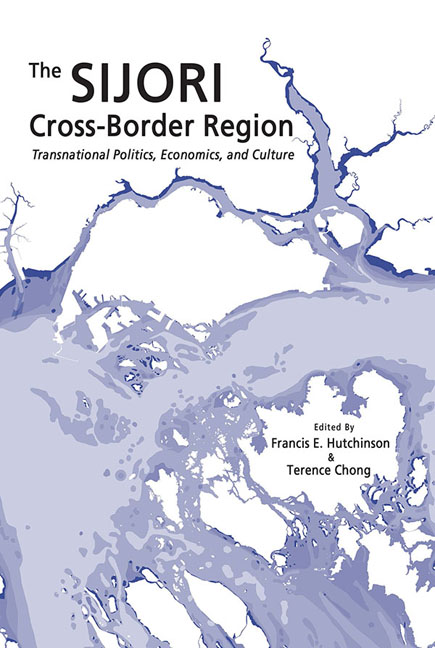Book contents
- Frontmatter
- Contents
- List of Maps
- List of Tables
- List of Figures
- Foreword
- Acknowledgements
- Contributors
- Abbreviations
- Introduction
- Section I Understanding the Whole
- Section II Policy and Politics
- Section III Cross-Border Social and Cultural Communities
- Section IV Formal and Informal Economies
- Conclusion
- Map6
- 18 The SIJORI Cross-Border Region: The Whole and Sum of Its Parts
- Appendix
- Sources for the SIJORI Maps
- Index
18 - The SIJORI Cross-Border Region: The Whole and Sum of Its Parts
from Conclusion
Published online by Cambridge University Press: 22 July 2017
- Frontmatter
- Contents
- List of Maps
- List of Tables
- List of Figures
- Foreword
- Acknowledgements
- Contributors
- Abbreviations
- Introduction
- Section I Understanding the Whole
- Section II Policy and Politics
- Section III Cross-Border Social and Cultural Communities
- Section IV Formal and Informal Economies
- Conclusion
- Map6
- 18 The SIJORI Cross-Border Region: The Whole and Sum of Its Parts
- Appendix
- Sources for the SIJORI Maps
- Index
Summary
INTRODUCTION
The previous chapters and maps in this book have explored the interactions between the territories of the SIJORI Cross-Border Region along a number of axes. The first section set out the contours of SIJORI in economic, demographic, and territorial terms, and sought to understand the CBR as more than just the sum of its parts. The second section explored the political interactions within and between the territories as they relate to the “project” of deeper cross-border ties. Following that, the third section looked at how the region's historical, cultural, and familial linkages mediate the borders as well as how interactions between the territories have given rise to different social and cultural phenomena. The fourth section looked at the formal and informal economies that have arisen — some consciously and others spontaneously — out of the interactions between the three territories.
The guiding themes for these chapters have been the two empirical questions set out in the introduction, namely: how have the three territories evolved as a result of the deeper interaction between them; and, what are they likely to look like in the future? In addition, the chapters have also collectively sought to shed light on the theoretical utility of the Cross-Border Region framework.
This concluding chapter will revisit each of the four sections of the book to paint a broad picture of what has happened within and between these territories, as well as draw out the implications for future developments. It will then bring the discussion back to the Cross-Border Region framework to evaluate what we have learned from applying it, and how it can be extended in light of the findings. From there, this chapter will suggest future areas of research before concluding.
UNDERSTANDING THE WHOLE
Using the three key dates of 1990, 2010–12, and 2030, the two chapters and associated maps in Section One explored the demographic, economic, and territorial interaction between Singapore, Johor, and the Province of the Riau Islands (PRI).
In 1990, SIJORI had a combined population of 5.7 million people, with 3 million in Singapore, 2.1 million in Johor, and 560,000 in PRI. In addition to having the biggest population, the city-state also represented the bulk of the CBR's wealth, accounting for 85 per cent of its combined GDP, with Johor and PRI contributing 11.6 and 3.2 per cent of the total, respectively.
- Type
- Chapter
- Information
- The SIJORI Cross-Border RegionTransnational Politics, Economics, and Culture, pp. 451 - 462Publisher: ISEAS–Yusof Ishak InstitutePrint publication year: 2016



